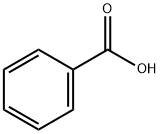Benzoic acid is the simplest member of the aromatic carboxylic acid family. It is a weak acid that is a precursor for the synthesis of many important organic compounds. More than 90 percent of commercial benzoic acid is converted directly to phenol and caprolactam. Its use in the production of glycol benzoates for the application of plasticizer in adhesive formulations is increasing. The organic compound is also used in the manufacture of alkyd resins and drilling mud additive for crude oil recovery applications. It is also used as a rubber polymerization activator, retardant, resins, alkyd paint, plasticizers, dyestuffs, and fibers.
Benzoic acid and its esters occur in apricots, cranberries, mushrooms and jasmine plants. The history of benzoic acid dates back to sixteenth century. In the year of 1875 Salkowski a prominent scientist discovered its antifungal abilities. In medicine, benzoic acid is the principal component of benzoin resin, and is a constituent of Whitfield’s ointment which is used for the treatment of fungal skin diseases such as tinea, ringworm, and athlete’s foot.

